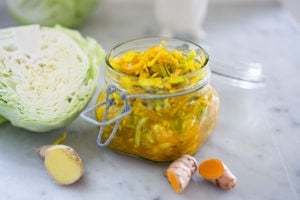Description
How to make Turmeric Sauerkraut- a small-batch recipe that can be put together in 10 minutes, and sits on the counter for 3-5 days!
Ingredients
Scale
- 1/2 organic cabbage- (1 pound) finely sliced, or shredded ( save one outer cabbage leaf for the top)
- 1/4 onion - finely sliced
- 2 garlic cloves- minced
- fine sea salt
- 1 teaspoon fresh ginger- finely chopped
- 1 teaspoon finely grated turmeric- or sub 1/2 teaspoon ground
- Optional additions- grated carrots, whole spices like caraway seeds, cumin seeds, coriander seeds, fresh herbs- use your imagination!
Instructions
- Slice cabbage and onion thinly ( you can also shred in a food processor or use a mandoline) and place in a bowl. Add the garlic, and ginger. Weight the cabbage-mixture in grams- take care not to weigh the bowl. Multiply the cabbage grams by .02. This is the amount of salt you will need in grams. See notes.
- Add the salt. Massage the cabbage well, which will open up its pores and allow for better fermentation.
- Add the turmeric and mix with tongs ( turmeric will stain your hands). Let stand in the bowl for 30 minutes to 2 hours, allowing the cabbage to release its liquid.
- Mix again and place into a clean, sterile jar, packing down hard, leaving 2 inches of headroom. If the liquid does not rise above the cabbage while pressing down, you can add a little brine. (*see notes). Cover with a cabbage leaf, pressing down. The cabbage must be under the brine to prevent mold.
- To keep the kraut pressed down under the surface of the liquid while it ferments, weigh it down with a small fermentation weight. Tuck it in the jar.
- Cover very loosely with a lid and place the bowl or pan, or a larger container, to catch any overflow. Place in a cool dark spot for for 3-5 days. (If your lid is loose, you won’t need to burp).
- Fermentation occurs faster in warmer months and slower in colder months. It likes to be around 60-72F. In summer, find a cooler spot, like the basement. TIP: Longer cooler ferments do offer up the best flavor.
- When you see a little activity, usually around 3 days (any signs of overflow, or bubbling when you give it a stir) feel free to taste it. You are tasting for a tangy sour flavor, which indicates it has fermented.
- Let it ferment and sour longer if you prefer (for a softer kraut) or keep it fresh and crunchy by placing it in the fridge to slow this process down.
- It is ready to eat once chilled and will taste better after a few days. Store in the fridge, for up to 6 months, with a loose lid, or with a tight lid (creating more bubbly ferment).
Notes
- Salt Ratio: The recommended salinity for Sauerkraut is 1.5% – to 2.5% salt to the weight of the cabbage. Here we use 2% salt to the weight of the cabbage. Example: 1ooo grams cabbage multiplied x .02= 2o grams of salt. Feel free to use more or less as long as it stays between 1.5% and 2.5%. I use Himalayan Sea Salt and Real Salt. Both are natural and unrefined with high mineral content.Cabbage: Use organic cabbage if possible. Do not use pre-shredded cabbage. You need the natural bacteria from a whole cabbage. Farmers’ market cabbage works especially well.In volume, the general salt to cabbage ratio is 2 ½ -3 tablespoons salt to 5 lbs cabbage. Or for every one pound of cabbage 1.5-1.75 teaspoons salt. (One large cabbage weighs about 2 pounds).
- Brine: If topping off with a saltwater brine, mix 1 ¼ teaspoons salt into 1 cup of water.
- Organic or farmers market cabbage often has the BEST results- that’s because the bacteria that ferments the cabbage actually comes from the surface of the cabbage to begin with. Garden grown or farmer’s market cabbage has more of this live bacteria still on it compared to grocery store varieties.
Nutrition
- Serving Size: ¼ cup
- Calories: 37
- Sugar: 0.5 g
- Sodium: 295.7 mg
- Fat: 0.1 g
- Saturated Fat: 0 g
- Carbohydrates: 8.3 g
- Fiber: 0.7 g
- Protein: 1.5 g
- Cholesterol: 0 mg
